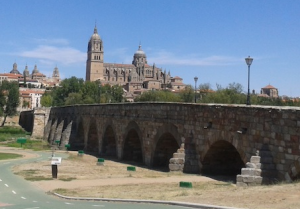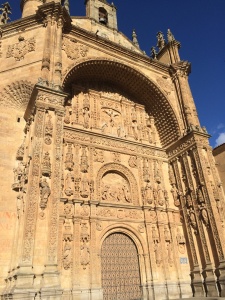Museums and Tourist Attractions

Palacio de Monterrey
This Renaissance style palace was constructed in 1539 and now belongs to the family of the Duke of Alba. The palace is named after the Count of Monterrey.
Convento de las Úrsulas
The Convent was founded by Don Alonso de Fonseca (patriarch of Alexandria) in 1512 under the name Convento de la Anunciación. This convent has a Gothic style and is characterized by its beautiful crown-like tower.
Clerecía
Temple and baroque convent built  by the Jesuits in the 17th century (1617) under the name “School of the Holy Spirit.” Its first architect was Juan Gómez de Mora (constructor of the Plaza Mayor in Madrid). On the prominent twin towers (a work by Andrés García de Quiñones), one can find an image of the virgin flanked by the figures of Phillip III and Margaret of Austria, its patrons. The sanctuary has many paintings attributed to Rubens and an excellent multicolored sculpture of the crucified Christ, sculpted by Carmona.
by the Jesuits in the 17th century (1617) under the name “School of the Holy Spirit.” Its first architect was Juan Gómez de Mora (constructor of the Plaza Mayor in Madrid). On the prominent twin towers (a work by Andrés García de Quiñones), one can find an image of the virgin flanked by the figures of Phillip III and Margaret of Austria, its patrons. The sanctuary has many paintings attributed to Rubens and an excellent multicolored sculpture of the crucified Christ, sculpted by Carmona.
Casa de las Conchas
T his monument has both Gothic and Renaissance influences, and was constructed in the last quarter of the 15th century (1493). It is one of the most symbolic monuments in Salamanca, and representative of Spanish architecture during the Catholic Kings reign. It was constructed to celebrate the marriage of Knight Rodrigo Arias de Maldonado (governor of the city and department chair of the university) with Lady María de Pimentel. He was a member of the “Order of the Knights of Saint James of Compostela.” The members´ symbol was the shell (thus there are over 400 shells that decorate the outer walls). Lady María´s family seal is located above the main door, with the five flowers of lis.
his monument has both Gothic and Renaissance influences, and was constructed in the last quarter of the 15th century (1493). It is one of the most symbolic monuments in Salamanca, and representative of Spanish architecture during the Catholic Kings reign. It was constructed to celebrate the marriage of Knight Rodrigo Arias de Maldonado (governor of the city and department chair of the university) with Lady María de Pimentel. He was a member of the “Order of the Knights of Saint James of Compostela.” The members´ symbol was the shell (thus there are over 400 shells that decorate the outer walls). Lady María´s family seal is located above the main door, with the five flowers of lis.
University
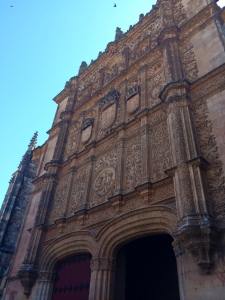
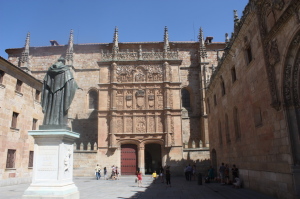 The Estudio Salmantino, as it was first called, is the third oldest university in Europe that still remains open to this day. The University was founded at the beginning of the 13th century (1218). It experienced its most prosperous period during the 15th and 16th centuries, when the greatest professors of the Holy Roman Empire taught in its classrooms.
The Estudio Salmantino, as it was first called, is the third oldest university in Europe that still remains open to this day. The University was founded at the beginning of the 13th century (1218). It experienced its most prosperous period during the 15th and 16th centuries, when the greatest professors of the Holy Roman Empire taught in its classrooms. 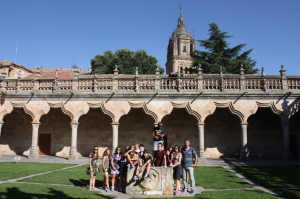
Artistically, its facade is the best example of the plateresque style. It is decorated with many symbols and images, which allude to virtues and vices. This facade, reinforced by lateral pillars and topped with Gothic pinnacles, is divided into three well-defined parts which are a representation of the social powers at the time of its construction.
Inside the building one notices the adorned Arabic-style ceiling and patio, the Renaissance stairway, the Paranifo, the baroque chapel, and the library furnished with baroque bookshelves.
Cathedrals
 Salamanca has two cathedrals: the old, or Roman, and the new, or Gothic. The first began its construction in 1140 and was finished in 1280. Thus its style is a mix of Roman and Gothic. The cathedral is divided into three chambers. The Renaissance altarpiece (painted by Nicolás Florentino and composed of 53 polychromatic tables representing scenes from the life of Christ and the Virgin) is one of the most prominent pieces of artwork in the interior.
Salamanca has two cathedrals: the old, or Roman, and the new, or Gothic. The first began its construction in 1140 and was finished in 1280. Thus its style is a mix of Roman and Gothic. The cathedral is divided into three chambers. The Renaissance altarpiece (painted by Nicolás Florentino and composed of 53 polychromatic tables representing scenes from the life of Christ and the Virgin) is one of the most prominent pieces of artwork in the interior.
The Torre del Gallo is characterized for its Roman, almost Gothic style due to its Byzantine influences. The tower gets its name from the rooster weathervane that rests atop the tower.
When the University started to gain international prestige at the end of the 15th century, the city outgrew the old cathedral. 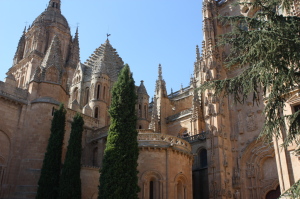 Therefore, the construction of a new cathedral began, and it wasn´t completed until two and a half centuries later (1730).
Therefore, the construction of a new cathedral began, and it wasn´t completed until two and a half centuries later (1730).
As a result of the prolonged construction, it is influenced by the various architectural styles that existed at this time: its structure is Gothic, while the interior and exterior are adorned in Gothic, Renaissance, Baroque and Neoclassic styles. The choir loft (a work by José Churriguera), chapels and the organ, are all baroque style.
Roman Bridge
The Puente Romano was built above the Tormes River around 200 B.C. The famous La Ruta de la Plata, which connected Mérida and Astorga, once crossed over this bridge. The bridge consists of 26 arches, the 15 arches that stand closest to the city center were constructed by the Romans.
Convento de los Dominicos and Iglesia de San Esteban
The church was sponsored by Friar Juan Álvarez de Toledo, and its construction began in 1524 under the direction of Renaissance architect Juan de Álava. Its most impressive elements are the plateresque facade and the altarpiece. The altar piece was designed by José Churriguera, and incorporates Spain´s first columns of Solomon (a baroque element). The early 16th century Renaissance style convent contrasts with the portal of the San Esteban church (Iglesia de San Esteban). The convent´s courtyard, known as The Kings Courtyard is gothic on the interior and plateresque on the exterior.
Plaza Mayor
Plaza 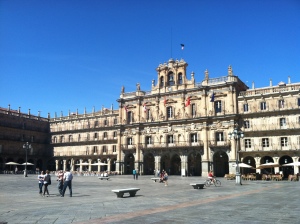 Mayor has a Baroque style, and it was constructed above an old market square in the 18th century. Interestingly its form is not square, but rather a trapezoid (each side has its own measurement) due to an error made by Alberto de Churriguera. Along the border there are 88 arcs, which are adorned with plaques of important historical and cultural Spanish figures. The eastern wall depicts the kings from Alfonso XI to Fernando VI, excluding that of Francisco Franco. On the southern wall are the conquistadors, and on the north and west wall are literary figures and others related to the history Salamanca.
Mayor has a Baroque style, and it was constructed above an old market square in the 18th century. Interestingly its form is not square, but rather a trapezoid (each side has its own measurement) due to an error made by Alberto de Churriguera. Along the border there are 88 arcs, which are adorned with plaques of important historical and cultural Spanish figures. The eastern wall depicts the kings from Alfonso XI to Fernando VI, excluding that of Francisco Franco. On the southern wall are the conquistadors, and on the north and west wall are literary figures and others related to the history Salamanca.
Casa Lis-Art Nouveau and Art Déco Museum
Casa Lis is an old modernist mansion, with beautiful stain-glass windows. The museum contains art collections from the Art Nouveau period. The collections are from the late 19th century to the First World War as well as from the interwar period. The collections of porcelain dolls, furniture, jewelry, fans, textiles, and bronze and enamel sculptures provide visitors a taste of what middle-class society was like during that time.






